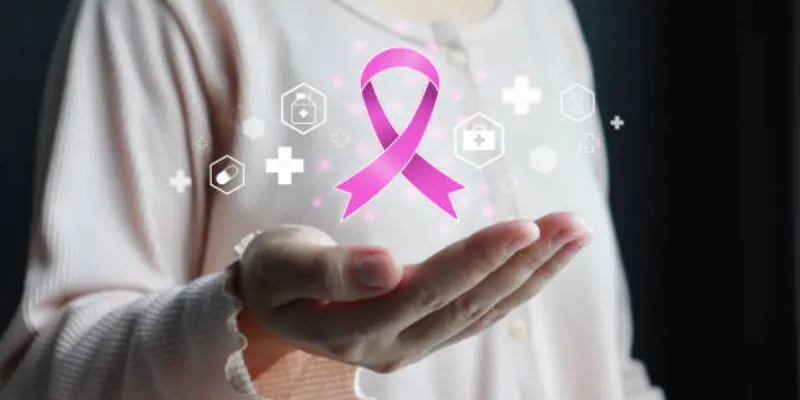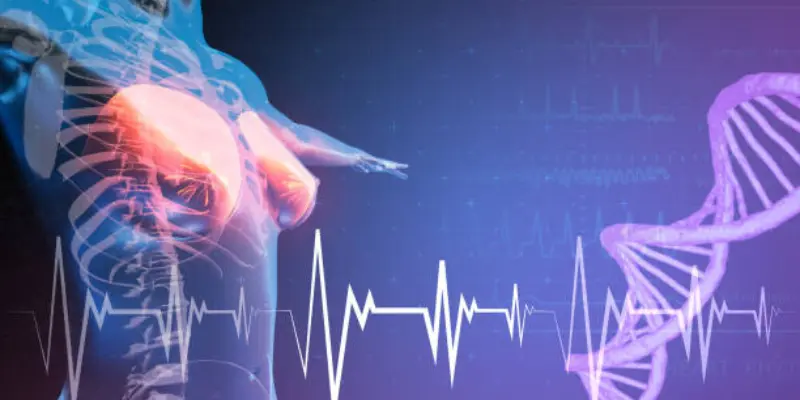The Role of AI in Breast Cancer: A New Way to Save Lives
Published: 13 May 2025
Breast cancer is one of the most common types of cancer in women. Finding it early can save lives. But sometimes, small signs get missed. AI is helping in early detection and diagnosis. It is like a smart computer that learns from data and helps doctors see things faster and more clearly. Today, AI tools can read breast scans, suggest treatments and even remind patients about check-ups.
Sounds amazing, right? In this blog, we will explore how AI helps in breast cancer care. Let’s dive in and see how this smart technology is making a big difference!

What Is AI and How Does It Help in Healthcare?
AI stands for Artificial Intelligence. That means a computer or machine that can think, learn and solve problems just like humans. But much faster.
When you use Google Maps, it finds the fastest route. When you shop online, it shows things you may like. That’s AI. Now, imagine if the same kind of smart thinking helps doctors fight diseases. That’s what’s happening in healthcare today.
How AI Helps in Healthcare
AI is changing the way doctors work. Here’s how:
- Reads Scans: AI can look at X-rays, MRIs and mammograms. It spots tiny details that a human eye might miss.
- Finds Patterns: It can study thousands of health records and find what treatments work best.
- Predicts Risks: It can tell if a person might get sick in the future based on their health data.
👉 Example: AI might look at a mammogram and say, “This spot looks like early cancer,” even when it’s hard to see.
How AI Helps in Breast Cancer
AI is becoming a trusted partner in the fight against breast cancer. It helps doctors and patients at every step from early detection to follow-up care. Let’s explore how it works in more detail.
1. Early Detection Through Imaging
Breast cancer is easier to treat when it’s found early. The most common way to find it is through a mammogram, which is an X-ray of the breast. But reading mammograms can be tricky. Tiny changes might not be easy to see, even for skilled doctors.
This is where AI helps. AI tools can look at thousands of mammogram images and learn what cancer looks like. Over time, these tools become very good at spotting even the smallest signs of trouble.
What AI Does:
- Highlights areas that look suspicious
- Compares new scans with past images
- Gives doctors a second opinion
2. Improving Diagnosis Accuracy
Sometimes, a lump or spot on a scan could be cancer or it might be something harmless. Doctors use their experience to decide but even experts can disagree.
AI helps by studying large amounts of data from past patients. It looks at patterns, what a cancerous lump looks like, how it grows and what symptoms come with it. Then it uses that knowledge to suggest if a case is likely cancer or not.
What AI Does:
- Reduces human errors in diagnosis
- Helps to confirm a doctor’s judgment
- Saves time by quickly analyzing the results
3. Creating Personalized Treatment Plans
Breast cancer is not the same for everyone. Some cancers grow slowly. Others grow fast. Some respond to one drug, while others don’t. That’s why every patient needs a personalized treatment plan.
AI can look at your test results, medical history, family background and even your DNA. Then it finds patterns and matches you with treatments that have worked for similar patients.
What AI Does:
- Analyzes large data sets to find the best treatments
- Matches treatments with patient profiles
- Helps doctors to choose drugs, therapies or surgery types

4. Supporting Follow-Up and Monitoring
After treatment, the journey is not over. Patients need regular follow-ups to make sure the cancer doesn’t return. AI can help here, too.
Smart apps and wearable devices powered by AI can track how patients feel, check their vital signs and remind them to take medicines or visit the doctor. Some AI tools can also flag warning signs early like if a patient reports pain or fatigue.
What AI Does:
- Sends reminders for check-ups and medication
- Monitors patient health data in real time
- Alerts doctors if there are warning signs
Real-Life Examples of AI in Breast Cancer Care
AI is not just a fancy idea. It’s already working in real hospitals, labs and clinics. Let’s look at some real examples where AI has made a big difference in breast cancer care.
1. Google Health’s AI Model for Mammograms
In 2020, Google Health created an AI tool that looks at mammograms and finds signs of breast cancer. It was tested in the U.S. and the U.K. with thousands of women.
AI Features:
- The AI tool caught more true cancer cases than human doctors alone.
- It also made fewer false alarms, which means fewer women had to worry about something that was not cancer.
2. IBM Watson for Oncology
IBM Watson is a well-known AI system that reads medical research and patient data. In breast cancer cases, it suggests treatment plans based on what worked best in similar cases.
AI Features:
- Watson helped doctors in India and China offer advanced care where cancer specialists were few.
- It used over 300 medical journals and millions of records to guide decisions.
3. Lunit INSIGHT MMG
This AI software from South Korea is used to analyze mammograms. It works alongside radiologists and improves accuracy in spotting tumors.
AI Features:
- Lunit’s AI found breast cancer with up to 96% accuracy in clinical studies.
- It is used in real hospitals in Korea, Brazil and Saudi Arabia.
4. Paige.AI and Pathology Reports
AI isn’t just used on X-rays. Some tools like Paige.AI, look at tissue samples under the microscope.
AI Features:
- These tools help pathologists confirm whether the cells are cancerous.
- They work faster than humans and help reduce mistakes in reports.
Challenges of Using AI in Breast Cancer
While AI has great potential from detection to treatment of breast cancer but there are some challenges to keep in mind:
| Limitations |
|---|
|
By being aware of these challenges, we can make sure AI is used in the best way possible alongside doctors to help in improving breast cancer care.
The Future of AI in Breast Cancer
AI is still making progress in healthcare and its role in breast cancer care is only going to grow. Here’s what the future could look like:
1. AI-Powered Early Detection Everywhere
- AI will make early detection even better: In the future, AI could spot cancer earlier and with greater accuracy.
- Access to AI in every clinic: Smaller clinics and rural hospitals could soon use AI for breast cancer screening and make it available to more people.
- Smart devices: AI might be used in home devices, so women can monitor their breast health at home, even before visiting a doctor.
Why It Matters:
Catching cancer earlier means better treatment options and higher survival rates.
2. AI and Personalized Treatment Plans
- Tailored treatments: AI will analyze more than just medical records. It will look at a person’s genetics, lifestyle and previous treatments to create the perfect plan for each patient.
- Faster decisions: AI will help doctors choose the best treatment in real-time, speeding up the process of care.
- Improved drug development: AI could also speed up the creation of new cancer drugs by predicting how they will work in different people.
Why It Matters:
Personalized treatment could lead to more effective therapies and fewer side effects.
3. AI-Assisted Surgery
- Smarter robots: AI-powered robots will help surgeons perform more precise and less invasive surgeries.
- Better outcomes: AI will help doctors plan surgeries and avoid complications, leading to quicker recoveries for patients.
Why It Matters:
AI could make surgeries safer and improve recovery times for breast cancer patients.
4. AI for Global Access to Care
- Bringing AI to low-resource areas: In the future, AI tools could be used in remote regions where expert doctors are not available.
- Affordable solutions: As AI technology becomes more affordable, it will level the playing field, offering the same cancer detection and treatment tools to people in poorer countries.
Why It Matters:
AI has the potential to provide quality healthcare to everyone, no matter where they live.
5. Collaboration with Doctors and Humans
- Doctors and AI will work together: The future of AI in breast cancer care is not about replacing doctors but about supporting them. AI will assist doctors with fast and accurate data while doctors provide their expert judgement and personal care.
- Constant learning: AI systems will keep learning and improving, adapting to new research and better treatments.
Why It Matters:
AI and doctors working together will lead to the best possible care for breast cancer patients.
Conclusion
So guys! In this article, we’ve covered AI in Breast Cancer in detail. It’s clear that AI has the potential to revolutionize the way we detect, treat and manage breast cancer. However, it’s also important to be aware of the challenges it faces from data privacy concerns to the need for doctor acceptance. My personal recommendation is to stay informed and supportive of technological advancements in healthcare, as these can lead to better outcomes for everyone. If you are interested in learning more about how AI is shaping the future of healthcare, don’t hesitate to explore our other articles on the topic. Stay ahead of the curve—follow TechieVisions today!
FAQs About AI in Breast Cancer
Here are the common questions answers:
No, AI is not meant to replace doctors but to assist them. It serves as a powerful second opinion tool that helps doctors make better decisions. Human expertise and compassion remain essential in breast cancer care.
AI-enhanced screening may initially cost more due to the technology investment. However, long-term savings can occur through fewer missed diagnoses and reduced unnecessary procedures. Some insurance companies are beginning to cover AI-assisted screenings as the technology becomes more standard.
AI can help to identify dense breast tissue cancers that traditional mammograms might miss. It’s particularly helpful for detecting lobular cancers that appear as subtle architectural distortions. However, no detection method is perfect, which is why multiple screening approaches are often used.
Healthcare AI systems must comply with strict privacy laws like HIPAA in the US. Your data should be encrypted and anonymized when used by AI systems. Always ask your healthcare provider about their specific data security measures.
AI doesn’t change the physical procedure of getting a mammogram. However, it might reduce the need for repeat mammograms or additional imaging. Some newer AI-guided systems are exploring less uncomfortable imaging techniques.
Many AI tools are being developed with accessibility in mind, including cloud-based solutions that don’t require expensive hardware. Adoption in smaller and rural hospitals is expected to increase significantly within the next 3-5 years. Government programs are also working to expand access to these technologies.
Yes, AI can analyze multiple factors to estimate recurrence risk. It can identify subtle patterns in imaging, pathology results and genetic markers that might indicate higher recurrence possibilities. This helps doctors create more effective follow-up monitoring plans.
Several smartphone apps use AI to help with breast self-exam reminders and guidance. Wearable devices with AI capabilities are still in development and clinical testing. Remember that these tools are a supplement; they do not replace professional medical care.
Medical schools are beginning to incorporate AI training into their curricula. Many hospitals provide specialized training programs for their staff when adopting new AI systems. Professional organizations also offer continuing education courses on healthcare AI.
AI has potential to democratize access to expert-level cancer screening regardless of location. However, AI systems must be trained on diverse populations to avoid perpetuating existing biases. Some researchers are specifically developing AI tools to address healthcare disparities.





